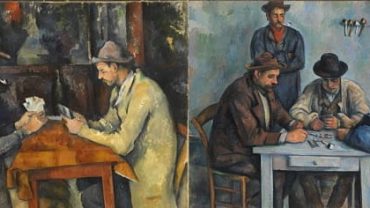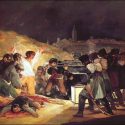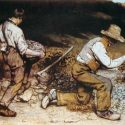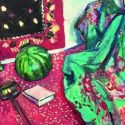Baroque Art – Characteristics, Definition & Style
If you are an art enthusiast, when you see a painting or research about a work;
“This masterpiece from the Baroque Period.”
You will see sentence entries such as. You would probably think about what characteristics that work was considered a Baroque period work. In this article, we are talking about the Characteristics of Baroque Art in order to answer your thoughts.
Characteristics of Baroque Art
What is Baroque?
In the history of art, there is an understanding of baroque art that followed the Renaissance period and the Mannerist movement in Europe and observed between 1580 – 1750.
The word baroque is derived from the Portuguese word “barocco” or the Spanish word “barucca“. The word Baroque means “irregular non-spherical shape of the pearl”.
The word baroque was used to insult the works that appeared after the Renaissance period. The word baroque reached its present meaning only in the 19th century.
PS- The word “Mannerism” is a term coined by 17th-century critics who accused late 16th century artists of pretense and empty imitation.
Relation of Baroque and Classical Art
The style in Baroque art; it can be evaluated as the loosening of solid, clear, and precise lines of classical art and the melting and fusion of forms in a composition. The calm and calm figure of the classic was mobilized in the “Baroque” style and silence turned into noise.
Classical works are produced based on some principles and rules. Baroque art does not recognize these rules and principles. The Baroque period places emphasis on more personal issues, whimsical forms, surprising, and influences. Baroque artists take the original, the new, and the modern as their subject.
Baroque art is not about the complete and perfect, but only about the active and the formed. It seeks not limited and easily comprehensible, but the limitless and huge. The ideal of beautiful proportions has disappeared, attention is attributed to the “event”, not the “presence”. We can define the understanding of Baroque art as neither the decline nor the rise of the classic. On the contrary, Baroque is a completely different art.
Baroque Art and Architecture
Michelangelo, one of the greatest artists of the High Renaissance, actually planted the seeds of the Baroque period as both a sculptor and an architect. However, the artist’s new interpretation of nature could not be developed by the artists who came after him.
Undoubtedly, the political structure of Europe has been influential in the development of Baroque architecture. Rich traders have emerged who have started to trade overseas.
Most of Europe was ruled by small principalities. These princes and wealthy merchants found it almost compulsory to build special architectural structures for their pleasures, which showed their power and glory. That’s why the importance given to their mansions and the money they spent on them was enormous.
At the same time, the structures of this period were an indicator of the artistic talent of the artist and architect.
In this period, art was not perceived as imitating nature, but rather as reshaping nature. Baroque-style architectural works made in this period, fountains, large and extraordinary magnificent sculptures, large gardens, enormous halls, wall carvings, god, and mythology paintings were the basic elements in the architecture of this period.
Baroque architecture was the first effective in Italy. Later, the baroque architectural style was adopted in the buildings built in Spain and Portugal. It has affected Germany and France and to a lesser extent the architecture in England. Baroque influence St. Petersburg and even in Istanbul.
Famous sculptors of the Baroque period
- Francesco Borromini
- Gian Lorenzo Bernini
- Pietro da Cortona
Masterpieces of Baroque Architecture
- Palace of Versailles-France

Palace of Versailles-France | Baroque Art
- Trevi Fountain-Italy

Trevi Fountain-Italy | Baroque Art
- Belvedere Palace-Austria

Belvedere Palace-Austria | Baroque Architecture
- St Paul’s Cathedral-London

St Paul’s Cathedral-London | Baroque Architecture
Masterpieces of Baroque Architecture in Turkey
- Nuruosmaniye Mosque-İstanbul

Nuruosmaniye Mosque-İstanbul | Baroque Art – Characteristics, Definition & Style
- Ayazma Mosque-İstanbul

Ayazma Mosque-İstanbul | Baroque Art – Characteristics, Definition & Style
Sculpture of the Baroque Period (Baroque Sculpture)
In the figures of Renaissance sculptures, the body and body parts and clothing are extremely balanced and unexciting. Although a facial expression that reflects emotion is seen in the mannerist sculpture figures, the figure is still in a balanced stance.
The sculptures are lively and enthusiastic in accordance with the art understanding of the period. Gestures and dress folds are exaggerated with light-shadow effect.
Generally, marble, rarely bronze, and wood were used in the works. The elegant and detailed body proportions are true to the original. Expressions such as excitement, fear, and violence are exaggerated. It is very important for the artist to show these on the face and body.
The greatest representative of the Baroque sculpture is Lorenzo Bernini (1598-1680). The artist, who is a sculptor and an architect, has come to be compared with Michelangelo because he reflects all the vitality and warmth of human skin in his sculptures.
Masterpieces of Baroque Sculpture
Gian Lorenzo Bernini
- David
- The Abduction of Persephone

The Abduction of Persephone by Gian Lorenzo Bernini | Baroque Art – Characteristics, Definition & Style
Pierre Puget
- Milo of Croton

Milo of Croton by Pierre Puget | Baroque Art – Characteristics, Definition & Style
Painting of the Baroque Period (Baroque Painting)
Mannerism acted not from nature, but from human imagination. However, this imagination has adopted the imaginary image of nature and has created art in this field. The recess and protrusion observed in Baroque architecture showed itself as light and shadow when transferred to baroque painting, that is, a two-dimensional environment.
There are differences between the understanding of baroque art followed between Northern Europe and the south of Europe. The understanding of baroque painting was born in Italy, just like the understanding of baroque architects.
Baroque is generally a movement that uses asymmetry as opposed to symmetry, nonlinear forms as opposed to geometric forms, movement as opposed to stationarity, and what is not easily comprehended in response to what is perceived at once.
It is possible to see whatever is against the ideal in a baroque style work, we can see smiling happy figures, sad figures, even blood, brutality, tears, broken heads. The figures are depicted in exaggerated movements as if they were on the stage in a very large theater.
As the wealthy merchant class began to order paintings, the lives of the saints were added to the mythological stories as well as the family histories and collective portraits.
Difference Between Baroque Art and Renaissance
When evaluated in terms of the features mentioned above, Baroque painting art can be explained as an opposition to the static and symmetrical rules introduced by the Renaissance. But as mentioned above; We can define Baroque art as neither the decline nor the rise of the classic. On the contrary, Baroque is a completely different art. In this sense, it is seen that Baroque and Renaissance art differs from each other with certain rules.
For example, it is observed that the light is reflected from a single source in a Renaissance painting, while in Baroque painting, the figures with the light on them are depicted as containing the light within themselves or the direction of the light is clearly perceived.
Innovations such as extending the proportions of the mannerist painters against the stereotyped style of the Renaissance, including light and color, have been a kind of support for Baroque painting artists.
It is seen that the unnamed pioneers of the style that emerged in the 17th century and called Baroque were 16th-century artists.
Some of the art historians have explained the birth of this style with the Contur – reforme movements initiated by the church against the Reformation.
The artists who adopted the Contre – reform took it upon themselves to fuel the excitement of the communities and create enthusiasm and excitement on the audience. During this period, art began to be remembered with showiness, and aesthetic and technical arrangements were made in architecture, painting, and sculpting to provide movement, glitz, and show.
Now, let’s take a brief look at what are the differences between the above-mentioned understanding of baroque art between Northern Europe and the south of Europe. Let’s do this review on Caravaggio and Peter Paul Rubens, the most important representatives of Baroque art.
Caravaggio is the first artist to increase the effect by highlighting the leading figures with light compared to others, thus adding a kind of magic to his paintings.
His figures are reflected in a versatile way in Caravaggio paintings. Light is not just for bringing the characters to the fore; He also used emotions such as determination, surprise, stagnation or fear to reflect abstract concepts.
Caravaggio has proven that with the correct use of directed light, an entire painting can be filled with feeling as if it were on a theater stage. Almost all the painters who came after him have benefited from this magnificent technique. He never hesitated to carry the ugly into his works and did not feel obliged to paint himself beautifully.
Baroque painting art in the 17th century can best be exemplified by Rubens, the difference that occurred in Northern Europe.
Peter Paul Rubens generally painted religious and mythological subjects, but when painting the human figure, he depicted the force effect on the bodies by exaggerating the muscular structure of men and reflected all the detail, beauty, and vitality of the skin on the female body. The artist had a distinctive Baroque expression by strengthening the color and movement elements with light-shadow contrasts.
In addition to giving what is natural with colors, Rubens’ search for the organic in human bodies can be explained by the appreciation of reality in his paintings.
It is seen that excitement and dynamism in the Baroque painting are reflected by color and form arrangements.
In terms of the use of color, colors in Rubens always depend on an object, despite the existence of a spiritual exuberance.
Masterpieces of Baroque Painting
Caravaggio
- Judith Beheading Holofernes (Giuditta e Oloferne)

Judith Beheading Holofernes (Giuditta e Oloferne) by Caravaggio
Peter Paul Rubens
- The Feast of Venus

The Feast of Venus, 1635 by Peter Paul Rubens









Your article gave me a lot of inspiration.
Thank you.
Thanks Ankur.
Your article helped me a lot. Thanks!
Thank you.